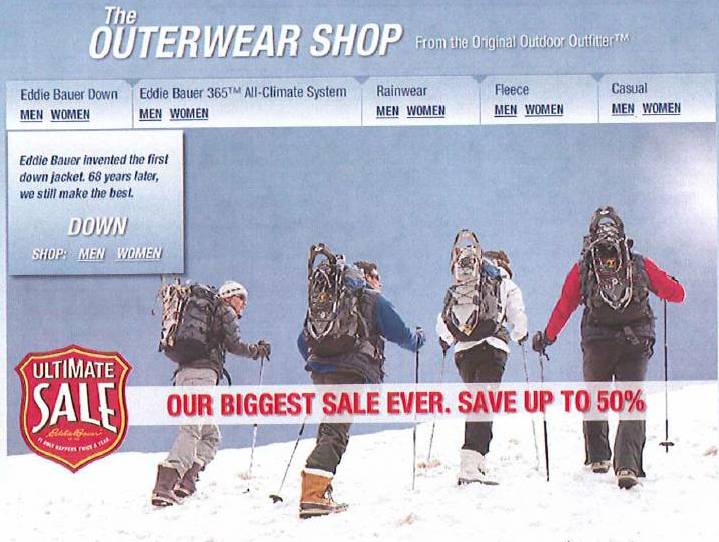Entries from January 1, 2009 - January 31, 2009
See You in Hawaii!

My better half and I are taking a week off in Kauai. I’ll be the relaxed sunburned guy with a smile on my face. If you see me, please say hello.
Back to blogging in about a week. If I return, that is.
Photo credit: Matt Wright
Woolrich Sues Eddie Bauer in Pennsylvania for Trademark Infringement

Plaintiff Woolrich, Inc., owner of a federal registration for THE ORIGINAL OUTDOOR CLOTHING COMPANY, has filed trademark infringement and dilution claims against Eddie Bauer, Inc., based on the Seattle company’s use of the mark THE ORIGINAL OUTDOOR OUTFITTERTM (as depicted in the sale flyer pictured above). Woolrich brought suit in the Middle District of Pennsylvania — Woolrich’s home district — on Jan. 6. The suit alleges that both companies compete in the outdoor clothing market and distribute their clothing through the same channels of trade. Eddie Bauer has not yet appeared or answered.
The case cite is Woolrich, Inc. v. Eddie Bauer, Inc., No. 09-0016 (M.D. Pa).
An Expert Witness Shares Insights on Trademark Surveys
As previewed yesterday, Graham & Dunn hosted an INTA roundtable on “Survey Evidence in Trademark Disputes.” We did things a bit differently than usual — we invited a testifying expert witness to speak. Deborah Jay, Ph.D., from the Field Research Corporation shared practical thoughts with the 15 trademark practitioners who attended.
Here are a few items of interest:
- It costs in the range of $75k to $100k through a survey expert’s report (for a likelihood of confusion survey).
- The expert will usually know if the survey will assist the litigation (i.e., whether it will deliver a helpful conclusion) after about $25k worth of work.
- If the attorney doesn’t get the results they want, they can terminate the survey and start over with a new expert. The terminated survey shouldn’t be discoverable since it is the work of a non-testifying expert.
- Giving an expert eight weeks of lead time to design and conduct the survey builds in time to start over if needed. However, some surveys can be done very quickly if necessary (i.e., within a few days).
- An expert’s critique of an opposing party’s survey costs in the range of $10k to $30k.
- Flaws generally do not lead to a survey’s exclusion; rather, they tend to diminish its weight.
- The most common reasons for exclusion are the use of leading questions and surveying the wrong universe of consumers (e.g., only surveying consumers in Seattle to determine consumer attitudes throughout Washington).
Graham & Dunn to Host INTA Roundtable on Survey Evidence in Trademark Cases
On Tuesday, Graham & Dunn will host the first INTA roundtable of 2009. The topic’s a good one — “Survey Evidence in Trademark Disputes.” Here’s what INTA says we will cover:
- Reviewing and analyzing surveys from past trademark cases;
- Finding out what is required in using surveys as evidence; and
- Learning strategies and techniques for developing proper surveys.
In addition, special guest Deborah Jay, Ph.D., will join us. Dr. Jay is CEO of San Francisco-based Field Research. Her experience as a testifying expert will provide extra insight into the strategic use of survey evidence in trademark cases.
Here’s a link to the discussion outline. I think INTA wants folks to have already registered, so if you have, I hope to see you there!
Hat’s off to my partner Kathleen Petrich for organizing!
Stanford IP Litigation Clearinghouse Database Appears to be Incomplete
As recently discussed, I’m a fan of the Stanford IP Litigation Clearinghouse. However, in working on my annual Western District Statistics post, I noticed a large discrepancy between the numbers that PACER indicates and the numbers the Clearinghouse counts. For example, the Clearinghouse states that 28 trademark cases were filed in the Western District last year. PACER puts the number at 51. The 2008 cases the Clearinghouse did not count were spread fairly evenly throughout the year, so it does not appear to be a matter of its database simply not being up-to-date. Most of the missing cases were both opened and closed in 2008, though not all fit that pattern. I can’t figure out why 23 cases show up in PACER but not the Clearinghouse, since I imagine PACER is the source of the Clearinghouse’s data. Perhaps someone from the Clearinghouse can shed some light. This is no knock against the Clearinghouse, which I view as an ambitious project that already provides a lot of value. (Among other things, it provides a docket sheet for all cases included in its database free of charge.) However, its database does not appear to be complete. Users should be aware of this apparent shortcoming. Hopefully, it will be corrected in the near future.
